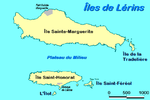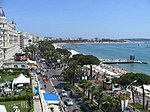Lérins Abbey
5th-century establishments in sub-Roman GaulBenedictine monasteries in FranceBuildings and structures in Alpes-MaritimesCannesCarolingian architecture ... and 2 more
Christian monasteries established in the 5th centuryCistercian monasteries in France

Lérins Abbey (pronounced [leʁɛ̃]) is a Cistercian monastery on the island of Saint-Honorat, one of the Lérins Islands, on the French Riviera, with an active monastic community. There has been a monastic community there since the 5th century. The construction of the current monastery buildings began around 1073. Today the monks cultivate vineyards and produce wine and liqueur.
Excerpt from the Wikipedia article Lérins Abbey (License: CC BY-SA 3.0, Authors, Images).Lérins Abbey
Allée de Ceinture, Grasse
Geographical coordinates (GPS) Address Nearby Places Show on map
Geographical coordinates (GPS)
| Latitude | Longitude |
|---|---|
| N 43.506388888889 ° | E 7.0475 ° |
Address
Abbatiale de Lérins
Allée de Ceinture
06407 Grasse
Provence-Alpes-Côte d'Azur, France
Open on Google Maps









